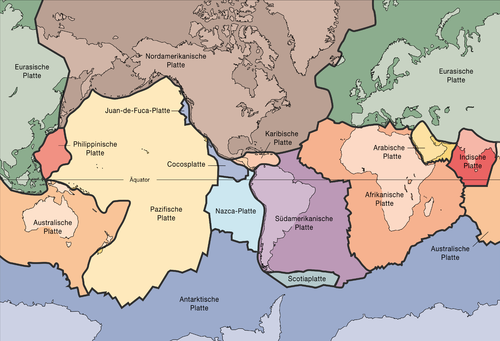Nazca Plate
![]()
This article or subsequent section is not sufficiently supported by evidence (e.g., anecdotal evidence). Information without sufficient evidence may be removed in the near future. Please help Wikipedia by researching the information and adding good supporting evidence.
The Nazca Plate is one of the smaller lithospheric plates that make up the Earth's crust and the uppermost part of the mantle. The tectonic plates play an essential role in the large-scale geological processes on Earth. The plate is named after the Peruvian port city of Nazca.
The Nazca Plate lies off the west coast of South America and belongs to the oceanic plates, which - except for a few small islands, such as the Juan Fernández Islands - are mainly covered by the sea. The plate moves eastward, where it collides with the South American Plate, a continental plate. When these two plates collided, the Nazca plate was pushed under the South American continent, where it dipped down to the lower mantle; a subduction zone was formed. Typical of these zones are the deep earthquakes, whose hypocenters can lie at depths of 320 to 720 km. At the boundary between the two plates, deep trenches formed, such as the Atacama Trench (up to 8065 m deep) in the south and the Peru Trench (up to 6369 m deep) in the northern part of the South American west coast. At the same time, the South American continent was uplifted. As a result of this plate shift, mountains were formed: along the entire west coast of South America, a large mountain range folded up, the Andes, with a height of up to 6962 m.
The Andes are part of the Pacific Ring of Fire, a space of the strongest seismic and volcanic activity. The highest volcanoes on earth are located here: Mount Pissis (Argentina), 6882 m high, and Ojos del Salado (Chile), 6887 m high. Post-volcanic phenomena such as solfataras, geysers and fumaroles are common.
To the north, the Nazca Plate borders the Cocos Plate, to the west it is bounded by the Pacific Plate and to the south by the Antarctic Plate. In the east it abuts the South American continent and is subducted there.
The Nazca Plate was formed by the fragmentation of the Farallon Plate at the beginning of the Miocene, about 23 million years ago. For the area between the Cocos Plate, the Caribbean Plate and the South American Plate, which is shown in the simplified maps of the lithospheric plates as the northern extension of the Nazca Plate, the existence of at least two microplates was postulated: the Coiba Plate in the north and the Malpelo Plate in the south.

Tectonic plates with continents in the background, in the middle (marked light blue) the Nazca plate
See also
- List of tectonic plates
Search within the encyclopedia